When traveling abroad, get a policy from one of the best travel insurance companies. You can get a 5% discount on Heymondo, the only insurance that pays all medical bills upfront for you, HERE!
There are hundreds of waterfalls in Iceland and seeing them all is practically impossible. Many of them are nameless and little-known while others are world-famous and have appeared in movies or TV shows. Regardless, they will make you stop the car and stand in awe of their beauty.
When it comes to choosing which waterfalls are worth visiting in Iceland, most travelers find it impossible to make up their minds. To help you plan your route, here are the best waterfalls in Iceland that you can’t afford to miss. They are the 25 most beautiful waterfalls in Iceland, either because of their natural surroundings or their utter greatness.
When you’re planning your itinerary and deciding what to do in Iceland, I recommend considering the waterfalls in this article. There are even some secret waterfalls in Iceland that you may unknowingly pass by if you don’t know exactly where they are. To avoid this, we’ve included a map of waterfalls in Iceland at the end of this guide.
Without further ado, these are the best waterfalls in Iceland.
1. Gullfoss, the most famous waterfall in Iceland’s Golden Circle
Gullfoss is one of the most popular waterfalls in Iceland. It is located near the Hvítá River within the Golden Circle of Iceland, one of the most popular routes from Reykjavik. This is where it gets its nickname, the Golden Waterfall.

1. Gullfoss, the most famous waterfall in Iceland’s Golden Circle
The most impressive thing about Gullfoss is that as you approach it, it looks like the earth is swallowing the water. In reality, the river continues flowing perpendicular to the waterfall through a narrow canyon. Gullfoss has three falls; the first and smallest is about 36 feet, the second is 70 feet, and the third and most impressive, is 105 feet.
The downside of Gullfoss’ location is that being one of the most popular stops along the Golden Circle, it’s always quite crowded with tourists. For this reason, there is a restaurant on the premises and the incredible Gullfoss hotel just five minutes away. This is definitely an essential waterfall to visit in Iceland, so don’t miss out!
The waterfall is located less than 75 miles from Reykjavik. To get there, you’ll need to rent a car or book an excursion like this one that includes a visit to Gullfoss among other interesting places along the Golden Circle.
2. Bruarfoss, the most beautiful waterfall of Iceland
Although choosing the most beautiful waterfall in Iceland is difficult, I must admit that Bruarfoss is gorgeous. It’s located along the Golden Circle, approximately nine miles from the town of Laugarvatn. For me, it’s a must-see along this route.
Iceland’s Bruarfoss waterfall, unlike many in the country, does not stand out for its size or grandeur, but for its lovely turquoise color. In fact, locals call it the Blue Waterfall of Iceland. It’s this striking hue that makes it one of the most beautiful waterfalls in Iceland.
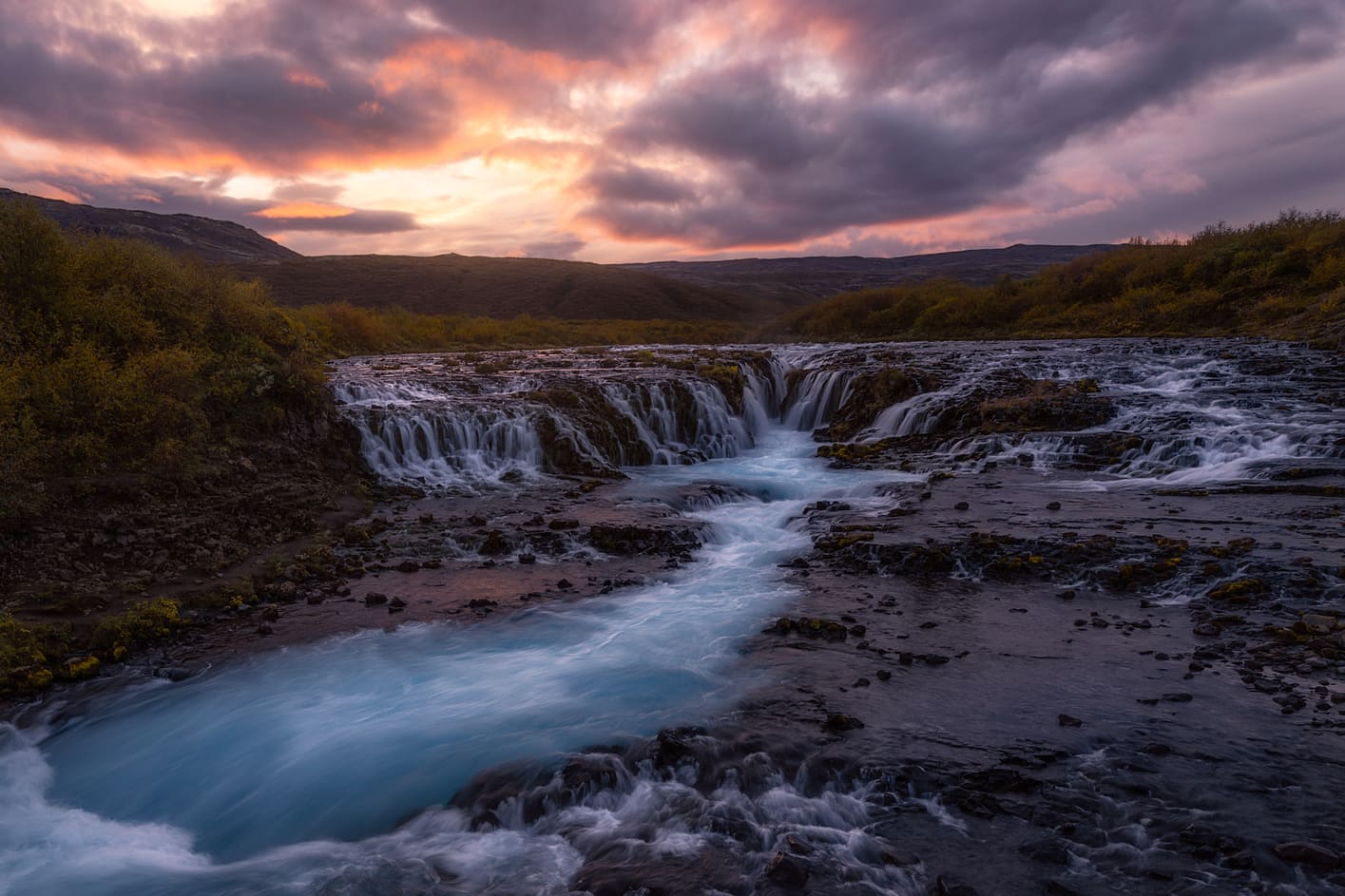
2. Bruarfoss, the most beautiful waterfall of Iceland
It was also one of the most visited waterfalls until its access point was closed, increasing the five-minute walk time to 45. On the bright side, the longer walk makes Bruarfoss less of a tourist trap. It’s ideal for those that don’t mind some extra walking to see a standalone Icelandic wonder.
The owners of the lands that you had to walk through to access Bruarfoss got tired of all the tourist traffic, so they prohibited trespassing. Now, you must park in the official parking lot on Route 37 and walk about two miles along the Brúarà riverbank to the waterfall. It’s easy to get lost, so I suggest downloading our tourist map of Iceland where you’ll find two other waterfalls in the area.
You can also book this excursion that includes a tour of the Golden Circle with a stop at some of the most popular falls.
3. Seljalandsfoss, the Iceland waterfall you can walk behind
Seljalandsfoss is one of the waterfalls in Iceland that you just have to visit because it’s so impressive. It’s located on the Ring Road, in the south of the island, and is one of the most visited waterfalls in Iceland.
The Seljalandsfoss waterfall is the most beautiful fall on the Seljalands River, which comes from the Eyjafjalljökull glacier. It has a 197-foot drop surrounded by a stunning landscape. Also, you can walk behind it thanks to a small cave in the back. Although it’s very touristy, it’s still worth visiting. I recommend stopping by right before dusk so you can see the sun set behind the curtain of water.
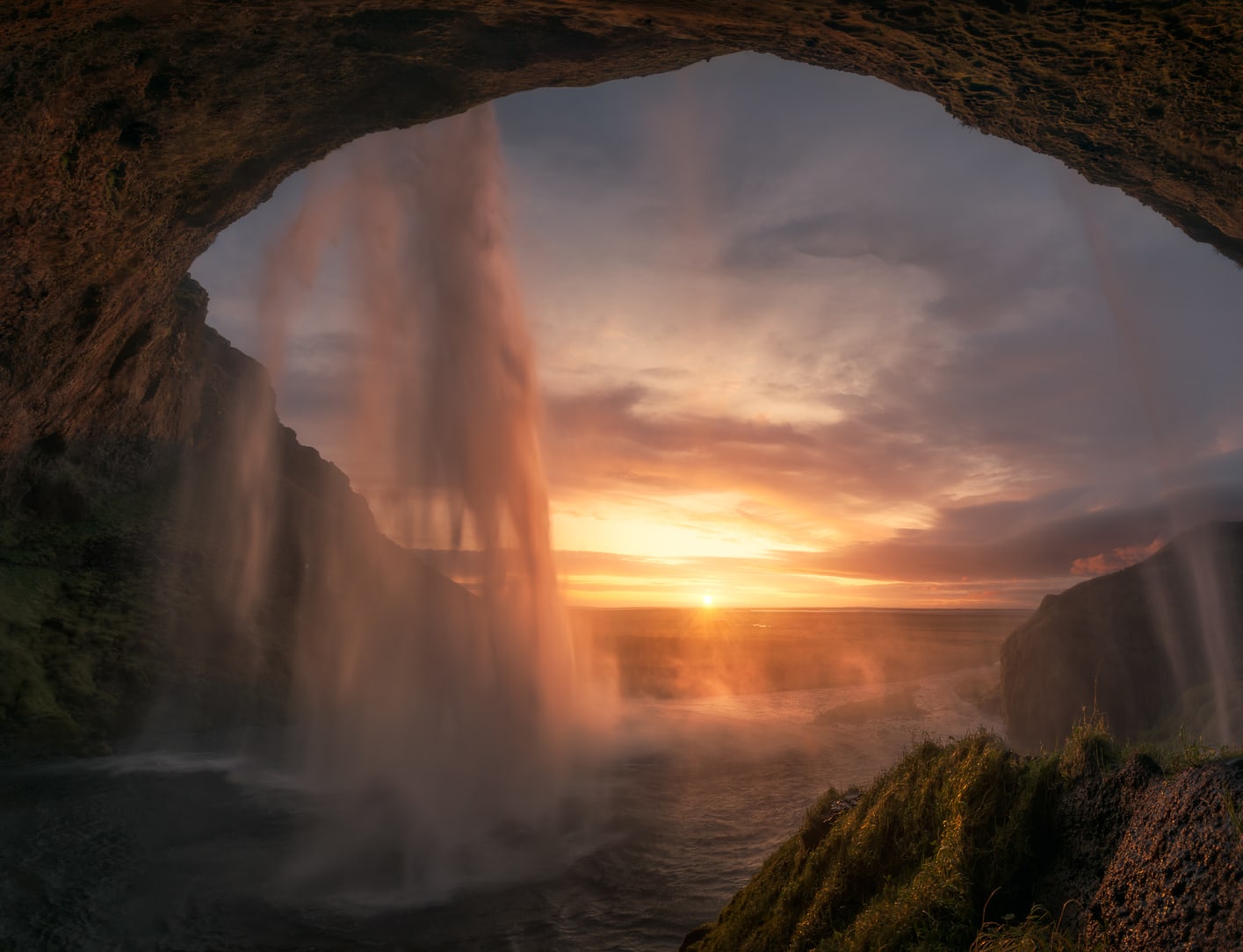
3. Seljalandsfoss, the Iceland waterfall you can walk behind
Getting to this waterfall in southern Iceland is very easy because it’s just off the Ring Road, about 80 miles from Reykjavik. You’ll have to take Route 1 and pass Hveragerði, Selfoss, Hella, and Hvolsvöllur. From there, you’ll be able to see the waterfall in the distance. The car park is at the turnoff to Road 249, right in front of the waterfall. While you’ll have to pay for parking, you’ll also be up close to this impressive waterfall.
If you don’t have a car, you can book this tour of southern Iceland from Reykjavik, which includes a stop at Seljalandsfoss.
4. Gljúfrabúi, the secret waterfall of Iceland
Very close to the Seljalandsfoss waterfall is one of the most beautiful secret waterfalls in Iceland, the Gljúfrabúi waterfall. It often goes unnoticed and many travelers don’t see it when they visit Seljalandsfoss because they’re unaware of its existence. However, Gljúfrabúi, despite being smaller and having a drop of only 131 feet, is a natural beauty you shouldn’t miss.
Gljúfrabúi is among the rare waterfalls in a cave in Iceland. It’s only visible upon entering the cave, which is why it’s known as the Secret Waterfall of Iceland. The entrance is somewhat narrow, and if you don’t want to end up with wet shoes, you’ll have to balance on the rocks in the river.

4. Gljúfrabúi, the secret waterfall of Iceland
If you’re going to visit the Seljalandsfoss waterfall, I suggest also stopping by Gljúfrabúi because it’s so unique. You can even walk along the fall but be very careful because the stones are wet and slippery.
You’ll find the Gljúfrabúi waterfall about a third of a mile north of the Seljalandsfoss waterfall. On the way, you will come across the Fosstúnsfoss, an ordinary waterfall with stunning surroundings.
Not all excursions that include the Seljalandsfoss waterfall include a visit to Gljúfrabúi, so if you don’t have a car, I suggest booking this tour, which includes the Eyjafjalljökull glacier’s most impressive waterfalls.
5. Skógafoss, the most famous waterfall in Iceland
Skógafoss is one of the most famous waterfalls in Iceland. Its waters also come from the Eyjafjalljökull glacier, and it’s also one of the most visited falls. This Icelandic waterfall is located at the end of the Skógá River in the village of Skógar, about 95 miles from Reykjavik along the Ring Road. It is also known as the Perfect Waterfall.
It has a nearly 200-foot drop and is about 80 feet wide. It really is spectacular thanks to its unique location. The water cascades onto black stones that are surrounded by green slopes in summer and snow in winter. In fact, it may look familiar as one of the waterfalls in Iceland in Game of Thrones. It’s also one of the best places to see a rainbow during the sunny days, especially after a rainstorm.

5. Skógafoss, the most famous waterfall in Iceland
This waterfall in southern Iceland can be seen from below as well as above. To enjoy incredible views, climb the 400 or so steps to the very top. From there, you can take the Fimmvörðuháls, one of the most popular Iceland hikes. This 16-mile trail takes you past glaciers, waterfalls, and lava fields. If you don’t have enough time to do the entire hike, the first part of the trail is still very beautiful and includes other waterfalls of the Skógá River.
If you don’t have a car, you can get there by booking this tour from Reykjavik.
6. Kvernufoss, the best waterfall in Iceland
The Kvernufoss waterfall is one of my favorite Icelandic waterfalls. You can find it in a canyon near the Skógafoss waterfall, which you can walk to. Best of all, it isn’t overcrowded with tourists, so you can visit and take photos in peace. You’ll want to take pictures because Kvernufoss looks like it came out of a fairytale.
It has a 100-foot drop and its waters come from the Kverná River, which originates from the Eyjafjallajokull glacier too. This waterfall is particularly special because you can walk behind it, just like Seljalandsfoss.

6. Kvernufoss, the best waterfall in Iceland
To get to it from Skógafoss, simply park your car at the Skógar Museum and head along the path that continues to the east. Keep in mind that you’ll have to jump the fence that keeps all the horses from getting away. From there, you’ll only have to walk about 15 minutes along the river.
If you don’t have a car or don’t want to drive in Iceland, I recommend this excursion, which includes a stop at this island’s secret waterfall, among others.
7. Öxarárfoss, a must-see Icelandic waterfall
Öxarárfoss is a small waterfall in Iceland that you can find at Thingvellir National Park.
The waterfall flows from the Öxara river and is surrounded by volcanic rocks. It has a 65-foot drop, so it isn’t one of the highest waterfalls in Iceland. However, it’s very important because its waters flow through the fissure separating the American and Eurasian tectonic plates. It’s certainly deserving of a spot on this list of the best waterfalls in Iceland.

7. Öxarárfoss, a must-see Icelandic waterfall
If you decide to visit the Thingvellir National Park, it’ll be easy to find this waterfall since the park has great signage. Thingvellir is part of the Golden Circle and is less than 30 miles from Reykjavik.
If you don’t have a car, you can book this excursion, which will take you to Öxarárfoss and other waterfalls in Iceland’s Golden Circle that you won’t find on most itineraries.
8. Svartifoss, one of the best waterfalls in Southern Iceland
The Svartifoss Waterfall in Skaftafell National Park is known as the Black Waterfall of Iceland because it sits on basalt columns. These columns formed after a volcanic eruption, as the hot magma quickly crystallized due to the low temperatures of Iceland. As you stand in front of this waterfall, notice the organic forms. They’re truly a magnificent work of nature.
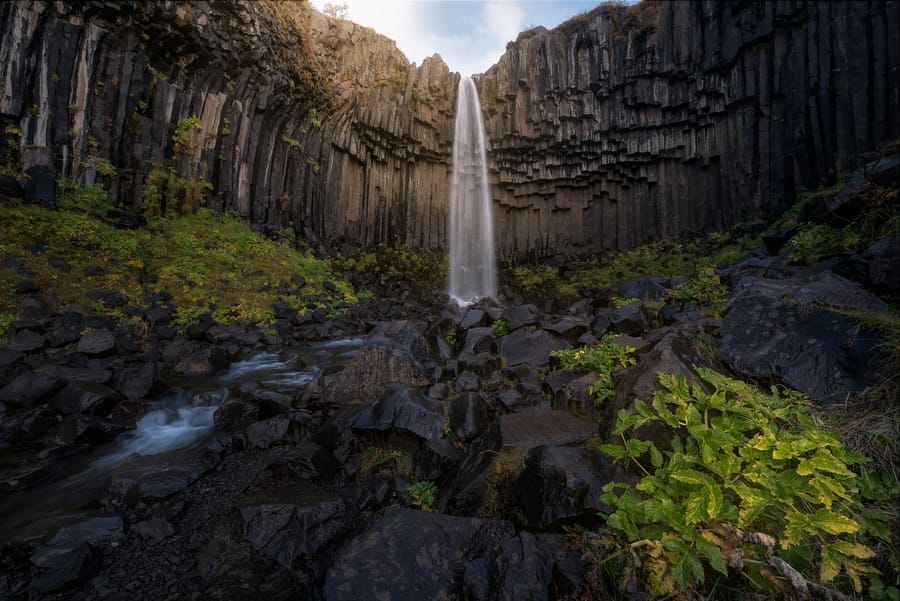
8. Svartifoss, one of the best waterfalls in Southern Iceland
To get to the Svartifoss waterfall, you’ll have to travel along the famous Ring Road to Skaftafell National Park. Once there, you must walk about one mile (two miles round-trip), which isn’t difficult, but the path is steep. That said, it’s totally worth it because you’ll pass two other impressive waterfalls on the way.
Although the Svartifoss waterfall is worth visiting any time of year, it’s one of the most beautiful waterfalls in Iceland during the fall thanks to the spectacular colors of the surrounding foliage.
9. Hengifoss, one of the best waterfalls in East Iceland
The Hengifoss waterfall is one of my favorite waterfalls in east Iceland, so I highly recommend it if you’re going to visit this area of the country. At 420 feet, it’s one of the highest waterfalls in the country, and a spectacular one at that.
The waters of the Hengifossá River forcefully descend from the black basalt walls. If you look closely, you’ll notice red horizontal strips of clay, the result of multiple layers of eruptions. This is certainly one of the most amazing waterfalls in Iceland.

9. Hengifoss, one of the best waterfalls in East Iceland
Hengifoss is very close to Lake Lagarfljót and about a 30-minute drive from Egilsstaðir. From the Ring Road, you’ll have to take Route 931 and follow the first section of Route 933. After parking there, you’ll have to walk 40-60 minutes to the waterfall. It can be a bit difficult if you’re not in good shape, but the walk itself is quite pleasant. During the walk, you’ll see another waterfall, Litlanesfoss, which is also known for its surrounding basalt columns.
10. Selfoss, one of the most well-known waterfalls in Iceland
The Selfoss waterfall is near the Jökulsá á Fjöllum River in northern Iceland. It’s one of the most impressive and well-known waterfalls in Iceland. Many travelers agree that it’s one of the most beautiful too.

10. Selfoss, one of the most well-known waterfalls in Iceland
What’s unique about this waterfall is that it’s very wide, creating an elongated stretch of flowing water. At 35 feet, it’s not very tall, but its appearance is just as impressive as any other waterfall.
You can view the Selfoss waterfall along with the Dettifoss waterfall, which I’ll also tell you about. To get there from Route 864, you’ll need a 4×4 vehicle. However, if you’re traveling along Route 862, the road is paved, so you can drive a 2WD car.
11. Dettifoss, the most powerful waterfall in Iceland
The Dettifoss waterfall is the largest waterfall in Iceland and in all of Europe. In fact, the water vapor from the falls can be seen for miles. It’s located downstream from the Selfoss waterfall and upstream from the Hafragilsfoss waterfall, which are close enough to visit. These three waterfalls all flow from the Fjöllum River.
Dettifoss is about 330 feet wide and has a nearly 150-foot drop. Its flow rate can vary depending on the time of year, as it’s affected by glacial melt. On average, it has a flow rate of about 650 ft/s, although rates as high as 1,650 ft/s have been recorded. You really can’t fathom how big this waterfall is until you’re next to it.

11. Dettifoss, the most powerful waterfall in Iceland
As I mentioned, if you travel with a 4×4 vehicle, you’ll be able to take Route 864. This is the best option because you’ll approach the waterfall from the east, giving you a more intense view. If you don’t have a 4×4, you can take Route 862 to the west. The view is more direct, so you can’t get too close or see too much because of the water vapor from the falls. Still, it’s worth seeing Dettifoss firsthand to get a feel for how large and impressive it is.
12. Goðafoss, one of the most beautiful waterfalls in Iceland
The Goðafoss waterfall, or Waterfall of the Gods, is in the north of Iceland. I think it’s one of the most beautiful falls in the country, especially at sunset. It flows from the Skjálfandafljót river, at the foot of the Ring Road and about 30 miles from Akureyri. Legend says the waterfall got its name when Icelanders converted to Christianity and threw the Viking god statues over the falls.

12. Goðafoss, one of the most beautiful waterfalls in Iceland
The waterfall is 100 feet wide and has a 40-foot drop. Despite its small size, Goðafoss is very beautiful. It owes part of its appeal to the rocky ledge that splits the water in two, creating a small waterfall.
You can visit this Icelandic waterfall from both sides by taking a short walk from either parking lot. It takes less than 10 minutes and the path is marked with clear signs.
13. Dynjandi, one of the highest waterfalls in Iceland
The Dynjandi waterfall is one of the highest waterfalls in Iceland and one of the most beautiful. Its waters resemble a bridal veil cascading down the rocks. It’s located in the western fjords along the shores of Arnarfjörður.
This waterfall has seven cliffs spanning 330 feet. Its width increases from 100 feet at the top to 200 feet wide at its base. These undulating cliffs are what create the “bridal veil” and make Dynjandi so breathtaking. It’s undoubtedly one of the most spectacular landscapes in Iceland and a true wonder of nature.

13. Dynjandi, one of the highest waterfalls in Iceland
To get to this waterfall, which is located 50 miles from Isafjordur, take Route 60 to the Arnarfjörður fjord. The journey to the Dynjandi waterfalls in Iceland takes about 1 hour and 30 minutes, but the views are amazing, so it’s well worth it.
14. Haifoss, one of the biggest waterfalls in Iceland
Haifoss is one of the largest waterfalls in Iceland at 400 feet tall. It’s also very close to the Hekla volcano and flows from the Fossá River.
The waterfall is in a spectacular canyon. The cloud of steam that rises from the falls creates a rainbow over the precipice, making it one of the most-photographed waterfalls in the country. Next to it is the smaller Granni waterfall, which comes from the same river but separates a little earlier. Depending on where you stand, you may see both these waterfalls at the same time.

14. Haifoss, one of the biggest waterfalls in Iceland
Haifoss waterfall is one of my favorites to see at sunset. The play of colors is spectacular at this time of day. That said, getting there is a bit of a challenge. You need to take a 4×4 vehicle because the surrounding roads are usually in bad shape. Drive along Route 32 and merge onto Route 332. If you don’t have a car, consider booking this excursion from Reykjavik to the Highlands with a stop at this beautiful waterfall.
15. Aldeyjarfoss, the best waterfall in North Iceland
Aldeyjarfoss is in the northern Highlands of Iceland. The waterfall flows from the Skjálfandafljót river, right at the point where there is a 65-foot drop.

15. Aldeyjarfoss, the best waterfall in North Iceland
I consider it one of the most beautiful waterfalls in north Iceland because of its basalt columns. Like the Svartifoss waterfall, what makes Aldeyjarfoss special is the contrast of the black basalt with the intense blue water. While it’s absolutely stunning, it’s not one of the most visited waterfalls in Iceland because it’s far from the more touristy areas. Even so, I think it’s well worth the little detour.
Of course, you’ll need a 4×4 vehicle to traverse the unpaved roads. If you’re coming from Goðafoss, you’ll have to travel along Route 1 or the Ring Road until you reach the turnoff to Route 842. After a while, Route 842 becomes F-26, which leads to the waterfall. If you continue along this road, you can also visit the Hrafnabjargafoss waterfall.
16. Flögufoss, one of the best Icelandic waterfalls off the beaten path
We had to include Flögufoss on this list of the most spectacular waterfalls in Iceland. It’s in eastern Iceland, a little over 10 miles from the fishing village of Breiðdalsvík. It’s part of the Flöguá River and has a nearly 200-foot drop.
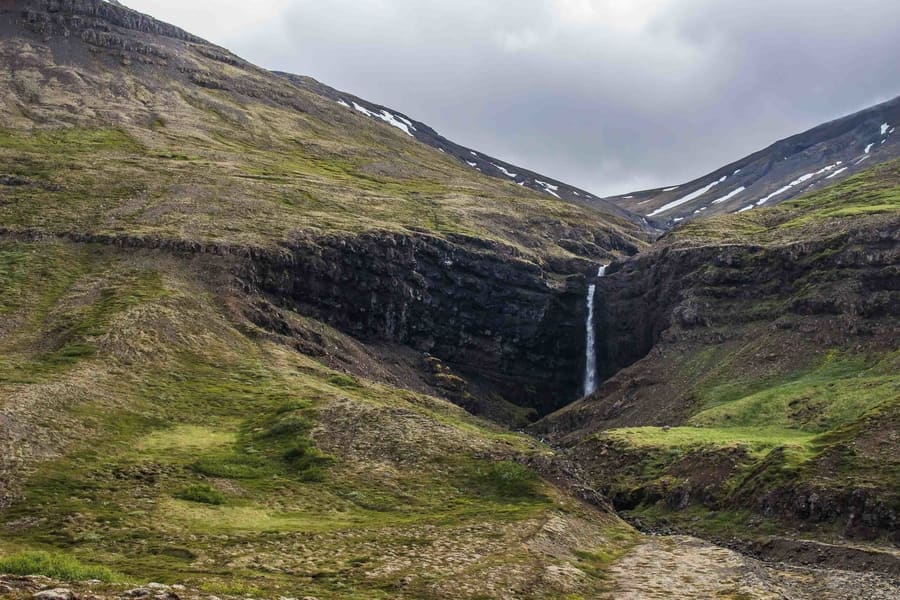
16. Flögufoss, one of the best Icelandic waterfalls off the beaten path
The Flögufoss waterfall is in a beautiful setting that already makes it worth visiting. Yet, the most striking thing about this waterfall is that it passes under a stone arch, which makes it even more breathtaking. Today, it’s considered one of the must-see waterfalls in Iceland, although this wasn’t always the case. Over years of erosion, the waterfall shifted to where it is now under the arch.
Getting to Flögufoss is very simple. From Breiðdalsvík, take Route 95 and turn onto Route 966. Once you get to the car park, you’ll have to walk about 15 minutes to get to the waterfall. I suggest approaching from the left side to get the best views.
17. Sigöldugljufur, the Iceland’s hidden waterfall
Not everyone who travels to Iceland includes Sigöldugljufur in their plans. Yet, visiting this little-known canyon provides a prime opportunity to see hidden waterfalls in Iceland.

17. Sigöldugljufur, the Iceland’s hidden waterfall
Sigöldugljufur is also known as the Valley of Tears due to its large number of waterfalls, which were created over years of geological changes. This created different branches of flowing water that cascade down the canyon wall. So, Sigoldugljufur is not one, but several naturally stunning waterfalls. If you can, travel here in autumn to see an incredibly colorful display of foliage. Of course, you’re sure to appreciate the beauty of this place any time of year.
To get to this waterfall in the Highlands, you’ll need a 4×4 vehicle. From Selfoss, you can take Route 30, then turn onto Route 32 until you reach a mountain road, the F-26. You have to continue on this road until you reach the F-208. You’ll see the canyon on your left, partially hidden from the road. Once you get to the parking lot, it’s a short 15-minute walk to the falls.
18. Reykjafoss, one of the less-visited waterfalls in Iceland
The Reykjafoss waterfall is one of the most amazing falls that I discovered during our last trip to Iceland. It’s in Skagafjörður, very close to Varmahlíð, and is one of the best hidden treasures in the country. Reykjafoss is part of the Huseyjarkvisl River and actually has two waterfalls. The first is quite small and the second is about 65 feet tall.

18. Reykjafoss, one of the less-visited waterfalls in Iceland
While this waterfall is beautiful, the best part about it is that it’s next to Fosslaug, one of the wildest hot springs in Iceland. It’s a true wonder for all the senses, and you can soak there while viewing the waterfall. Without a doubt, it’s a visit I highly recommend if you want to enjoy a spectacular landscape while getting in some relaxation time.
You can get to Reykjafoss from the town of Varmahlíð by following Route 1 or the Ring Road. From there, turn onto Route 752 until you reach Route 753, which is just minutes from the waterfall.
19. Kirkjufellsfoss, one of the most popular waterfalls in Iceland
The Kirkjufellsfoss waterfall is located on the Snæfellsnes peninsula. It’s very popular with tourists, but even if it’s crowded with people, it’s well worth a visit. This is especially true if you want a good place to see the Northern Lights in Iceland. Kirkjufellsfoss is also a perfect place to enjoy a beautiful sunset, thanks to the Kirkjufell mountain in the background. I suggest getting there early since the place usually gets crowded by tourists and photographers.

19. Kirkjufellsfoss, one of the most popular waterfalls in Iceland
The shape of the surrounding rocks makes it look like there are two waterfalls, especially when the flow rate is lower. Still, this makes for spectacular images.
Getting to Kirkjufellsfoss is easy. Take Route 54 and head west towards the village of Grundarfjörður. Within a couple of minutes, you’ll see the Kirkjufellsfoss waterfall parking lot.
20. Glymur, the second-largest waterfall in Iceland
Just over an hour from Reykjavik is the Glymur waterfall. It’s one of the tallest waterfalls in Iceland, so you can already get an idea of how impressive it is. With a drop of over 650 feet, it’s one of the most amazing waterfalls in west Iceland.

20. Glymur, the second-largest waterfall in Iceland
Unlike other waterfalls, this one can’t be accessed by car. Instead, you must hike about two miles (four miles round-trip). The path isn’t difficult, but it’ll take three or four hours. So, if you’re not used to walking in the mountains, it might be tough for you. That said, the views of the landscape are incredible.
If you want to get to Glymur from Reykjavik, take the Ring Road towards Mosfellsbær. After passing Grundarhverfi, turn onto Route 47 until you get to the Glymur parking area. From there, you’ll have to go the rest of the way on foot. If you don’t have a car, you can book this tour from Reykjavik.
21. Sigoldufoss, a forgotten waterfall in Iceland
Sigoldufoss is a waterfall in Iceland that practically no one goes to even though its blue water makes it as lovely as a postcard. It’s over 30 feet tall and flows from the Tungnaá River.

21. Sigoldufoss, a forgotten waterfall in Iceland
Unfortunately, a power plant was built very close to Sigoldufoss in 1981, which eroded the riverbed and the waterfall. This is a shame because it was probably even more spectacular back then. Even so, the tranquility of the area and the stunning blue water makes Sigoldufoss one of the must-see waterfalls in Iceland near Reykjavik.
To get to this waterfall, you’ll need a 4×4 vehicle so you can travel along the unpaved roads in this area. If you’re coming from Reykjavik, take the Ring Road and turn onto Route 26 before entering Hella. From there, the road changes to F-26. Just as you would to get to Sigöldugljufur, turn onto F-208 to get to Sigoldufoss.
22. Stuðlafoss, the best waterfall hike in Iceland
The Stuðlafoss waterfall is one of those waterfalls in Iceland that few travelers have visited, but for me it is one of the best, simply for the hike you have to take to get there. You can spot Stuðlafoss on the way to the Stuðlagil Canyon. It sits in the Jökuldalur Valley, which is one of the most spectacular landscapes in the country.

22. Stuðlafoss, the best waterfall hike in Iceland
Stuðlafoss is located halfway up the eastern slope along the most remote edge. For this reason, it’s a waterfall that few travelers visit. It stands out for its incredible basalt columns that were submerged under water until a hydroelectric power station and reservoir were built in 2006. This lowered the water level of the Jökla River, exposing the columns.
To get to Stuðlafoss from the Ring Road, take Route 95 from Egilsstaðir. Turn onto Route 931, then 933, and finally Route 910. Park your car near the pedestrian bridge to cross the east rim (Stuðlagil Canyon carpark) and hike the trail for half an hour. If you continue walking another 30 minutes, you’ll get a spectacular view of the Stuðlagil Canyon.
23. Klifbrekkufoss, an Icelandic waterfall you must visit
Klifbrekkufoss can only be visited in summer because in winter, due to harsh weather and road conditions, the government blocks access to the falls. Klifbrekkufoss is located near Egilsstađir and is one of those waterfalls in Iceland that you’ll never regret taking the time to visit.

23. Klifbrekkufoss, an Icelandic waterfall you must visit
This waterfall is made up of several small falls that cascade from a height of nearly 300 feet. This results in a flowing zigzag pattern that makes this waterfall unique. It’s quite a beautiful scene that deserves attention. The best thing about Klifbrekkufoss is that it’s not overcrowded with tourists, so it’s a great place to stop and take photos.
To get to this waterfall, you must take Route 1 from Egilsstađir towards Höfn. Then, you’ll be able to turn onto Route 953, which will lead to Klifbrekkufoss. The roads aren’t paved, so I suggest renting a 4×4 vehicle if you want to visit this waterfall.
24. Hraunfossar, one of the lesser-known Icelandic Waterfalls
Hraunfossar, also known as the Lava Falls, is in western Iceland. Although it’s one of the lesser-known waterfalls in Iceland, it’s quite unique thanks to the way its striking blue waters flow out from the earth. In autumn, the foliage creates a colorful display, making the place even more breathtaking. If you travel to Iceland during this time of year, I suggest planning some extra time to visit Hraunfossar.

24. Hraunfossar, one of the lesser-known Icelandic Waterfalls
There is another waterfall nearby, Barnafoss or the Children’s Waterfall. A somewhat disturbing legend revolves around this waterfall. Apparently, two children drowned here on Christmas Eve centuries ago. The mother then decided to break the arches that joined the rocks of the waterfall to prevent the tragic accident from happening again. If you take the time to visit the Hraunfossar waterfall, be sure to see Barnafoss as well.
If you’re traveling from Reykjavík, some 75 miles away, you’ll have to take the Ring Road towards Mosfellsbær. Then, turn onto Route 50 and then take Route 518 to Hraunfossar.
25. Þjófafoss, one of the best waterfalls in Iceland
Þjófafoss is last on our list of waterfalls in Iceland. It’s located along the Þjórsá River, on the eastern side of the Merkurhraun lava fields and to the southwest of Búrfell Mountain. Its name means Cascade of Thieves because, apparently, they used to drown thieves there.

25. Þjófafoss, one of the best waterfalls in Iceland
At first, Þjófafoss’ water flow (and that of the Porsha River) was quite low in the winter. During the summer months, the waters rose, so most people only visited the area at this time. Furthermore, since the construction of the Burfell Power Plant, the water flow is low during most of the year. Yet, I still consider Þjófafoss worth visiting because it’s such a beautiful sight to see.
If you’re traveling along the Ring Road, turn onto Route 26 between Selfoss and Hella. From there, you’ll see Þjófafoss on the left.
How many waterfalls are in Iceland?
Iceland has more than 10,000 waterfalls, although many of them don’t even have a name. Seeing them all is impossible, but I do recommend incorporating the 25 best waterfalls in Iceland into your itinerary. A journey through the Land of Fire and Ice isn’t complete without a visit to some of these incredible falls. You won’t regret it!
Waterfalls in Iceland map
To help you locate each of the waterfalls in this guide, here’s a map of the waterfalls in Iceland. This way, you’ll be able to find them during your trip without any issues, and you can decide which ones you’d like to visit. Just be sure to rent the right vehicle and carve out enough time to see these unique nooks and crannies in Iceland.
Now that you know the best waterfalls in Iceland, I wish you a safe and happy trip through this wonderful country. If you have any questions, you can leave me a comment and I will try to help you as much as I can. Enjoy!









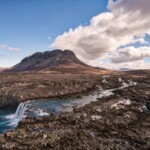








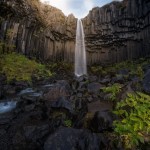
















I’m watching on TV a beautiful section of river with a low waterfall. The label says Fjlotshotn, Iceland. The internet doesn’t show me a hit for this place! Any ideas?
Hi Don!
My first thought was the Bruarfoss Waterfall, but that’s already in our article. There are unnamed waterfalls in Iceland along some of the rivers, so if you can find out the name of the river you saw on TV, that could help. Good luck!
Ascen
Thank you so much! Is there a tour to see all the 25 waterfalls? What is the best time to see the waterfalls?
Hi Jasmine,
I’m not aware of any tours that stop at all 25 waterfalls, but there are some excursions that include several Icelandic waterfalls in one trip. For example, this Golden Circle tour goes to the famous Gullfoss Waterfall, while this Southern Iceland tour visits Seljalandsfoss and Skógafoss.
Hope this helps! 🙂
thanks alot of information
Thank you!